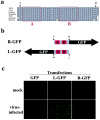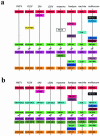Complete genomic sequence and comparative analysis of the tumorigenic poxvirus Yaba monkey tumor virus
- PMID: 14645589
- PMCID: PMC296094
- DOI: 10.1128/jvi.77.24.13335-13347.2003
Complete genomic sequence and comparative analysis of the tumorigenic poxvirus Yaba monkey tumor virus
Abstract
The Yatapoxvirus genus of poxviruses is comprised of Yaba monkey tumor virus (YMTV), Tanapox virus, and Yaba-like disease virus (YLDV), which all have the ability to infect primates, including humans. Unlike other poxviruses, YMTV induces formation of focalized histiocytomas upon infection. To gain a greater understanding of the Yatapoxvirus genus and the unique tumor formation properties of YMTV, we sequenced the 134,721-bp genome of YMTV. The genome of YMTV encodes at least 140 open reading frames, all of which are also found as orthologs in the closely related YLDV. However, 13 open reading frames found in YLDV are completely absent from YMTV. Common to both YLDV and YMTV are the unusually large noncoding regions between many open reading frames. To determine whether any of these noncoding regions might be functionally significant, we carried out a comparative analysis between the putative noncoding regions of YMTV and similar noncoding regions from other poxviruses. This approach identified three new gene poxvirus families, defined as orthologs of YMTV23.5L, YMTV28.5L, and YMTV120.5L, which are highly conserved in virtually all poxvirus species. Furthermore, the comparative analysis also revealed a 40-bp nucleotide sequence at approximately 14,700 bases from the left terminus that was 100% identical in the comparable intergene site within members of the Yatapoxvirus, Suipoxvirus, and Capripoxvirus genera and 95% conserved in the Leporipoxvirus genus. This conserved sequence was shown to function as a poxvirus late promoter element in transfected and infected cells, but other functions, such as an involvement in viral replication or packaging, cannot be excluded. Finally, we summarize the predicted immunomodulatory protein repertoire in the Yatapoxvirus genus as a whole.
Figures






Similar articles
-
Tanapox Virus and Yaba Monkey Tumor Virus K3 Orthologs Inhibit Primate Protein Kinase R in a Species-Specific Fashion.Viruses. 2024 Jul 8;16(7):1095. doi: 10.3390/v16071095. Viruses. 2024. PMID: 39066257 Free PMC article.
-
The genome sequence of Yaba-like disease virus, a yatapoxvirus.Virology. 2001 Mar 15;281(2):170-92. doi: 10.1006/viro.2000.0761. Virology. 2001. PMID: 11277691
-
Real-time PCR assay for the detection of tanapox virus and yaba-like disease virus.J Virol Methods. 2005 Dec;130(1-2):149-53. doi: 10.1016/j.jviromet.2005.06.015. Epub 2005 Jul 28. J Virol Methods. 2005. PMID: 16054706 Free PMC article.
-
Yaba-like disease virus protein Y144R, a member of the complement control protein family, is present on enveloped virions that are associated with virus-induced actin tails.J Gen Virol. 2004 May;85(Pt 5):1279-1290. doi: 10.1099/vir.0.79863-0. J Gen Virol. 2004. PMID: 15105545
-
Comparative genetic analysis of genomic DNA sequences of two human isolates of Tanapox virus.Virus Res. 2007 Oct;129(1):11-25. doi: 10.1016/j.virusres.2007.05.001. Epub 2007 Jun 14. Virus Res. 2007. PMID: 17574698
Cited by
-
Vaccinia virus F1L protein is a tail-anchored protein that functions at the mitochondria to inhibit apoptosis.J Virol. 2005 Jan;79(2):1084-98. doi: 10.1128/JVI.79.2.1084-1098.2005. J Virol. 2005. PMID: 15613337 Free PMC article.
-
Orthopoxvirus genome evolution: the role of gene loss.Viruses. 2010 Sep;2(9):1933-1967. doi: 10.3390/v2091933. Epub 2010 Sep 15. Viruses. 2010. PMID: 21994715 Free PMC article.
-
Prognostic correlations with the microbiome of breast cancer subtypes.Cell Death Dis. 2021 Sep 4;12(9):831. doi: 10.1038/s41419-021-04092-x. Cell Death Dis. 2021. PMID: 34482363 Free PMC article.
-
Tanapox Virus and Yaba Monkey Tumor Virus K3 Orthologs Inhibit Primate Protein Kinase R in a Species-Specific Fashion.Viruses. 2024 Jul 8;16(7):1095. doi: 10.3390/v16071095. Viruses. 2024. PMID: 39066257 Free PMC article.
-
Oncolytic Tanapoxvirus Variants Expressing mIL-2 and mCCL-2 Regress Human Pancreatic Cancer Xenografts in Nude Mice.Biomedicines. 2024 Aug 12;12(8):1834. doi: 10.3390/biomedicines12081834. Biomedicines. 2024. PMID: 39200298 Free PMC article.
References
-
- Afonso, C., E. Tulman, Z. Lu, L. Zsak, N. Sandybaev, U. Kerembekova, V. Zaitsev, G. Kutish, and D. Rock. 2002. The genome of camelpox virus. Virology 295:1-9. - PubMed
-
- Amano, H., Y. Ueda, and T. Miyamura. 1995. Identification and characterization of the thymidine kinase gene of Yaba virus. J. Gen. Virol. 76:1109-1115. - PubMed
-
- Ambrus, J. L., E. T. Feltz, J. T. Grace, Jr., and G. Owens. 1963. A virus-induced tumor in primates. Natl. Cancer Inst. Monogr. 10:447-458.
Publication types
MeSH terms
Substances
Associated data
- Actions
LinkOut - more resources
Full Text Sources
Other Literature Sources

